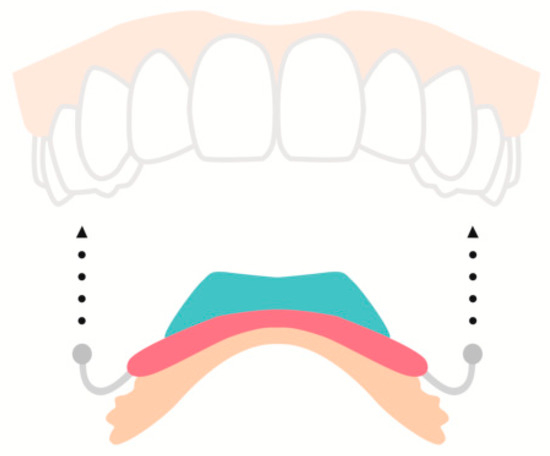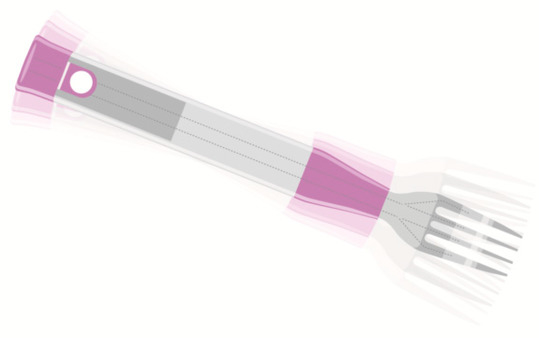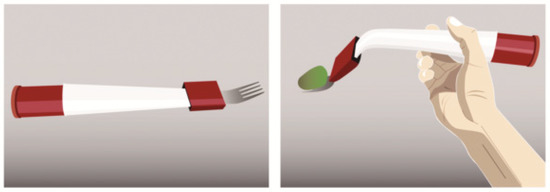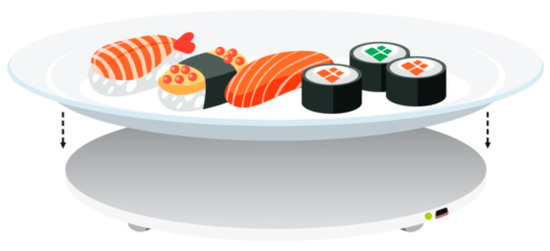Eating rate, as well as food texture and habitual characteristics, are considered important factors that affect an individual’s food intake. A novel way of manipulating eating rate and thereby potentially decreasing energy intake is via the use of specially made devices and cutlery. The aforementioned slow eating rate by decreasing oral volume and bite size, by modifying their shape (vibrating or deflating) when eating rate is accelerated or by special recordings of eating events and eating speed and then training the subject to modify them.
- eating rate
- devices
1. Noninvasive Oral Devices
An oral device, custom-made for each individual, designed to decelerate eating rate by decreasing oral volume and bite size was studied in obese/overweight individuals in a 4-month open label trial (Figure 1) [1]. The device is placed in the upper palatal space and secured by metal clasps around the teeth before initiation of the meal and is removed after termination. Participants exhibited a 5.2% weight loss while using the aforementioned device accompanied by a hypocaloric diet. Participants reported eating slower even when the device was not used [1].

Figure 1. This oral device is placed in the upper palatal space and is secured by metal clasps right before initiation of eating. A microchip (shown in blue) records the device’s temperature in order to monitor the user’s compliance. It is designed to decelerate eating rate by decreasing oral volume and the size of each bite [1].
Intraoral splints for both the upper and lower jaw, extending about 3 mm over the premolars and molars, reduce oral capacity by 25% and alter eating behavior without preventing users from eating [2]. At a 12-month follow-up in a study where the device was used for a total of 4 to 8 weeks, all participants exhibited weight loss of up to 5% and an impressive 67% experienced 10% weight loss [2].
Furthermore, objects of everyday use, like cutlery, could be potentially modified in order to decrease eating rate, i.e., smaller spoons resulted in a decrease in ad libitum food intake by 8%, decreasing both mean bite size and eating rate [3]. A smart fork has been designed in order to assist the user to maintain a slow eating rate by determining meal duration and calculating total number of bites (Figure 2) [4]. The device vibrates and a red-light indication appears every time eating rate is accelerated (more than one bite per 10 sec) [4]. A three-armed parallel randomized controlled trial consisting of a group using the fork with vibrating feedback, a second group using the fork with access to online data (for eating rate and success ratio feedback), and a third group using the fork with no feedback resulted in weight loss in the intervention groups [5]. At a follow-up, participants maintained a decreased eating rate by longer spacing between bites and a lower bite rate [5].

Figure 2. A smart fork that helps the user to decrease eating rate by calculating eating speed and meal duration. A red-light indication and a vibration appear when eating rate is accelerated [4].
A pneumatic fork that changes its body shape by inflating and deflating through a small pump and valve has also been used for the detection of accelerated eating rate (Figure 3) [6]. It bends when deflated, making it unable to eat with [6].

Figure 3. A pneumatic fork that changes its body shape by inflating and deflating through a small pump and valve depending on the detected eating rate [6].
2. Wearable Devices
The detection and monitoring of eating habits can also be conducted using smart eyeglasses with integrated electromyography electrodes on each side that provide skin contact with the ears [7]. Via high detection of chewing and eating events (ca 80%), the device could possibly contribute to dietary monitoring [7]. A device providing visual feedback via an application on a smartphone attempts to manage body weight by manipulation of eating rate [8]. An electronic scale is connected via Bluetooth with the smartphone and measures the gradual reduction in food on the plate. Self-recording of hunger and fullness is also available on the screen (Figure 4) [8].

Figure 4. A custom-made electronic scale that is connected via bluetooth with a smartphone application measuring the reduction of the food placed on the scale along with self-recording of hunger and fullness [8].
References
- Toni L. McGee; Mariee T. Grima; Ian D. Hewson; Kay M. Jones; Ellen B. Duke; J B Dixon; First Australian Experiences With an Oral Volume Restriction Device to Change Eating Behaviors and Assist With Weight Loss. Obesity 2011, 20, 126-133, 10.1038/oby.2011.303.
- Peter Von Seck; F. Martin Sander; Leon Lanzendorf; Sabine Von Seck; Andre Schmidt-Lucke; Mirja Zielonka; Caroline Schmidt-Lucke; Persistent weight loss with a non-invasive novel medical device to change eating behaviour in obese individuals with high-risk cardiovascular risk profile. PLOS ONE 2017, 12, e0174528, 10.1371/journal.pone.0174528.
- Lewis John James; Tyler Maher; Jack Biddle; David R. Broom; Eating with a smaller spoon decreases bite size, eating rate and ad libitum food intake in healthy young males. British Journal of Nutrition 2018, 120, 830-837, 10.1017/s0007114518002246.
- Sander Hermsen; Jeana H. Frost; Eric Robinson; Suzanne Higgs; Monica Mars; Roel C.J. Hermans; Evaluation of a Smart Fork to Decelerate Eating Rate. Journal of the Academy of Nutrition and Dietetics 2016, 116, 1066-1068, 10.1016/j.jand.2015.11.004.
- Sander Hermsen; Monica Mars; Suzanne Higgs; Jeana H. Frost; Roel C.J. Hermans; Effects of eating with an augmented fork with vibrotactile feedback on eating rate and body weight: a randomized controlled trial.. International Journal of Behavioral Nutrition and Physical Activity 2019, 16, 90-11, 10.1186/s12966-019-0857-7.
- Zhang Zuoyi; Kim Junhyeok; Sakamoto Yumiko; Han Teng; Irani Pourang IRANI1; Applying a pneumatic interface to intervene with rapid eating behaviour. . Studies in Health Technology and Informatics 2019, 257, 513, 10.3233/978-1-61499-951-5-513.
- Rui Zhang; Oliver Amft; Monitoring Chewing and Eating in Free-Living Using Smart Eyeglasses. IEEE Journal of Biomedical and Health Informatics 2017, 22, 23-32, 10.1109/jbhi.2017.2698523.
- Maryam Esfandiari; Vasileios Papapanagiotou; Christos Diou; Modjtaba Zandian; Jenny Nolstam; Per Södersten; Cecilia Bergh; Control of Eating Behavior Using a Novel Feedback System.. Journal of Visualized Experiments 2018, 135, e57432, 10.3791/57432.
